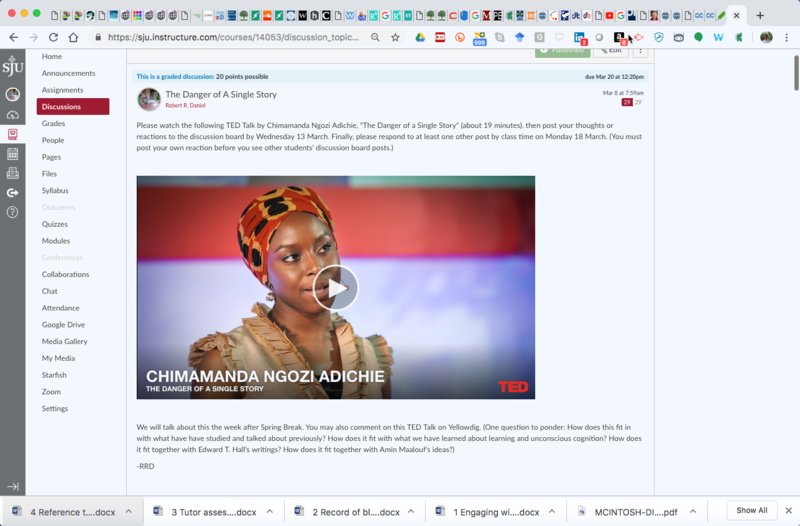Multimodal Literacies MOOC’s Updates
discussion board task (watch a video) = mixed modalities & increased cognitive difficulty
This example displays the ways in which I use switching between oral and written language, as a way of encouraging my students to process certain ideas in multiple ways and to notice both overlaps and divergences between presentations of ideas in spoken or texual forms. In this case, it is a discussion board task, where I ask them to watch and listen to a video, paying attention to ideas that may echo readings that we had done previously. Here is a screen capture of the task:
Here is a link to the video itself:
And here are my written directions to the students:
Please watch the following TED Talk by Chimamanda Ngozi Adichie, "The Danger of a Single Story" (about 19 minutes), then post your thoughts or reactions to the discussion board by Wednesday 13 March. Finally, please respond to at least one other post by class time on Monday 18 March. (You must post your own reaction before you see other students' discussion board posts.)
At the end of the discussion board directions (and after the embedded video), I add the following prompts:
We will talk about this the week after Spring Break. You may also comment on this TED Talk on Yellowdig. (One question to ponder: How does this fit in with what have have studied and talked about previously? How does it fit with what we have learned about learning and unconscious cognition? How does it fit together with Edward T. Hall's writings? How does it fit together with Amin Maalouf's ideas?)
So, basically, I am asking students to switch between reading (previously read excerpts from books by Edward T. Hall and Amin Maalouf, as well as students' individual and reading group notes about those readings) and spoken language (the recorded TED Talk by Chimamanda Ngozi Adichie). Obviously my invitation to relate these distinct artifacts indicates to the students that there are bases for comparison and finding conceptual echoes between these different manifestations of language. I invite students to respond first in a relatively formal writing forum (the discussion board), but I also suggest that they can comment in an informal fashion on the Yellowdig.com social-media-flavored discussion tool that we use in this class. (The writing there sometimes more closely resembles spoken language.) And I tell them that we will talk about the video. So students both read and listen, processing the ideas in distinct modalities, with their divergent cognitive and sensory forms. They also know that I expect them to write and to speak in response to my prompts, comparing ideas expressed in different modalities. In a word, I expect a lot of cognitive and expressive labor from my students.
My goals in mixing up modalities like this are twofold. First, I wanted to use the video to break up a long stretch of relatively dense readings. By shifting modalities, it keeps the theme we are exploring new and interesting. At the same time, by asking students to compare ideas expressed in different modalities, learners must first work relatively hard to process and understand those ideas and to put different authors' words (ideas and frameworks) in relation with the others'. Then, in asking students to respond to my written prompts both in writing and in speaking (in-class discussion), I am once again asking students to work hard and to process everything more than once, across different cognitive and sensory pathways.
In the end, this series of activities (watching a video, capturing its principal ideas, putting them in relation with other authors' ideas, explicitly commenting on the similarities and differences in writing, then talking about them face to face in class) is challenging. It asks the student to do a lot of cognitive work -- to comprehend, analyze, remember and respond across a mix of modalities. By asking learners to work so hard, it is my hope that they will have created more durable memories of the ideas we are dealing with. By using multiple retrieval pathways to pull those memories and those concepts out of long-term memory back into active working memory, students remember better and more durably.
(By the way, students think that because the task is a video, that it is an "easier" exercise, since it's not a dense reading. However, I know that I'm actually making them do harder cognitive work -- and multiplying the pathways to retrieval of the ideas -- by mixing modalities.)


